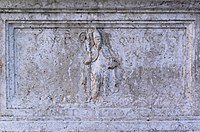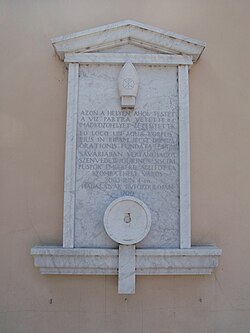Quirinus of Sescia
Quirinus of Sescia | |
|---|---|
Roman Catholic Church | |
| Canonized | Pre-Congregation |
| Major shrine | Basilica of San Sebastiano fuori le mura, Rome, Italy |
| Feast | 4 June |
| Attributes | millstone hanging from his neck [1] |
| Patronage | Sisak |
Quirinus (
A Passio, considered unreliable,[2] states that Quirinus was killed during the persecutions of Diocletian after being arrested in 309. Quirinus had attempted to flee but was imprisoned. He managed to convert his jailer, named Marcellus, to Christianity. After three days, the governor of Pannonia Prima, Amantius, ordered him taken to Sabaria (present-day Szombathely, Hungary), where after attempting to make Quirinus abjure his faith, he had the bishop thrown into the local Gyöngyös River with a millstone around his neck.[2]
A variant of the legend states that he was almost killed during Diocletian's persecution of Christians: the authorities tied him to a millstone and threw him into a river, but he freed himself from the weight, escaped and continued to preach his faith.
Veneration


Local Christians of Savaria recovered his body and buried it near the gate known as the "Scarabateus" (likely at Sopron).[2]
Upon the incursion of the
His cult became popular, as attested by the Itineraries of the 7th century.
Quirinus became considered one of the national protectors of the Republic of San Marino after a dense fog attributed to him by the Sammarinese on his feast day of June 4, 1543, thwarted an attempted conquest of the country by Fabiano di Monte San Savino, nephew of the later Pope Julius III.[7] The Franciscan Capuchin Church of San Quirino was subsequently built in the capital of San Marino around 1550.[8]
A church is dedicated to him at Jesenovik, Croatia. His feast is observed on 4 June.
References
![]() This article incorporates text from a publication now in the public domain: Herbermann, Charles, ed. (1913). "Sts. Quirinus". Catholic Encyclopedia. New York: Robert Appleton Company.
This article incorporates text from a publication now in the public domain: Herbermann, Charles, ed. (1913). "Sts. Quirinus". Catholic Encyclopedia. New York: Robert Appleton Company.
- ^ Stracke, Richard (2015-10-20). "Altar Frontal of the Madonna and Child with Saints".
- ^ a b c d e f Borrelli, Antonio. "San Quirino di Siscia" santiebeati.it; accessed 8 December 2015.(in Italian)
- ^ Kirsch, Johann Peter. "Sts. Quirinus." The Catholic Encyclopedia Vol. 12. New York: Robert Appleton Company, 1911. 23 November 2017
- ^ Monks of Ramsgate. “Quirinus”. Book of Saints, 1921. CatholicSaints.Info. 24 February 2017
- ^ Borrelli, Antonio. "San Quirino di Tivoli", santiebeati.it; accessed 8 December 2015.(in Italian)
- ISBN 978-953-7442-04-0.
- ^ Nevio and Annio Maria Matteimi The Republic of San Marino: Historical and Artistic Guide to the City and the Castles, 2011, p. 20.
- ^ Church of San Quirino. SanMarinoSite. Retrieved January 4, 2020.
